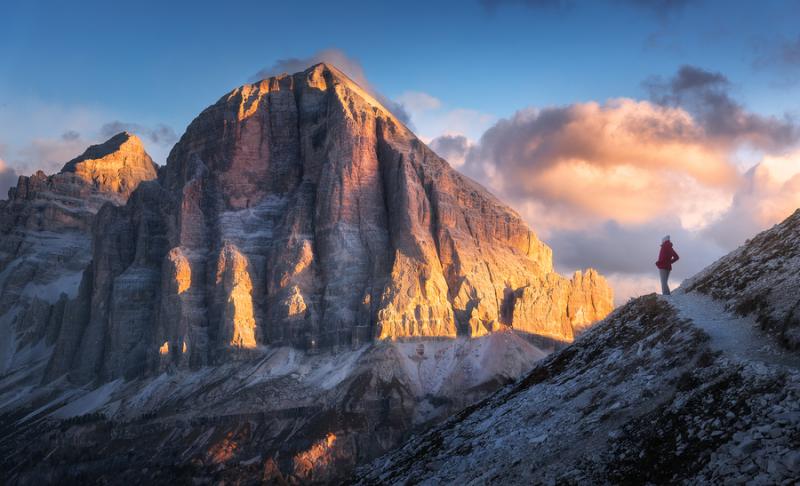Unesco Sites of Italy: The Dolomites
ITA:

Use player to listen to Italian version
“Each mountain in the Dolomites is like a piece of art,” said legendary mountaineer Reinhold Messner, who was born and trained in these mountains in northern Italy, before going on to become the first man to climb all fourteen peaks over 8,000 meters, including the first ascent of Everest without supplemental oxygen.
Extending from the River Adige in the west to the Piave Valley in the east, and from the Puster Valley in the north to the Sugana Valley in the south, the Dolomites are almost equally shared among the provinces of Belluno, Bolzano and Trento. It is a serial site that comprises nine areas covering 140,000 hectares in total with many peaks higher than 3,000 meters.
They were declared a Unesco World Heritage site in 2009 for their natural beauty (“some of the most beautiful mountain landscapes anywhere,” writes Unesco) and for their geological and geomorphological significance, “marked by steeples, pinnacles and rock walls, […] glacial landforms and karst systems. […] dynamic processes with frequent landslides, floods and avalanches. […] one of the best examples of the preservation of Mesozoic carbonate platform systems, with fossil records.”
The Dolomites take their name from the carbonate rock ‘dolomite,’ named for French geologist Dieudonné Dolomieu, who was the first, in the late 1700s, to describe this mineral found in large quantities in this mountain range.
At sunrise and sunset, the rocks that make up the mountains take on pink, purple, and red hues: locals call this phenomenon enrosadira. This process can be explained by the fact that up until 250 million years ago, these mountains were a mass of shells, corals and algae under the sea.
Fun fact: The coniferous forests in the Dolomites contributed to the foundation of the Venice Republic. The trees cut from the forest were used to build the foundations of Venice; because the city was founded on a lagoon, the soft ground on which it rested needed to be strengthened in order to construct buildings above, and this was achieved by planting an enormous number of wooden piles coming from the Dolomites through the mud into the bed of the lagoon.
Today, the Dolomites are a paradise for outdoors lovers, renowned for skiing in the winter months and for mountain climbing, hiking, cycling in all other seasons.
“Ogni montagna delle Dolomiti è come un'opera d'arte”, ha detto il leggendario alpinista Reinhold Messner, nato in queste montagne del nord Italia dove compì i primi passi nel mondo dell’alpinismo, diventando poi il primo uomo al mondo ad aver scalato tutti i 14 ottomila, incluso l’Everest senza utilizzo di ossigeno supplementare.
Con un’estensione che va dal fiume Adige ad ovest fino alla valle del Piave ad est e dalla Val Pusteria a nord fino alla Valsugana a sud, le Dolomiti sono quasi equamente divise tra le province di Belluno, Bolzano e Trento. Sono un sito seriale che comprende nove aree per una copertura di 140.000 ettari in totale con molte cime che superano i 3.000 metri di altezza.
Sono state dichiarate Patrimonio dell'Umanità per la loro bellezza naturale (“tra i più bei paesaggi montani al mondo”, scrive l’Unesco) e per la loro importanza geologica e geomorfologica, caratterizzate come sono da “guglie, pinnacoli e pareti rocciose, [...] morfologie glaciali e sistemi carsici. […] Processi dinamici con frequenti frane, alluvioni e valanghe. […] Uno dei migliori esempi di conservazione dei sistemi di piattaforme carbonatiche mesozoiche, con reperti fossili. ”
Le Dolomiti prendono il nome dalla roccia ‘dolomia’, così chiamata in onore del geologo francese Dieudonné Dolomieu, che fu il primo, intorno alla fine del 1700, a descrivere questo minerale che si trova in grandi quantità nella regione.
All'alba e al tramonto, le rocce che compongono le Dolomiti cambiano colore, assumendo tonalità che vanno dal rosa al viola al rosso: questo fenomeno è chiamato enrosadira e si spiega per il fatto che fino a 250 milioni di anni fa, queste montagne erano una massa di conchiglie, coralli e alghe sotto il mare.
Una curiosità: le foreste di conifere delle Dolomiti contribuirono alla fondazione della Repubblica di Venezia. Gli alberi tagliati dalle foreste furono usati per costruire le basi di Venezia; poiché la città fu fondata su una laguna, il terreno soffice su cui poggiava doveva essere rafforzato per potervi costruire edifici, e ciò fu ottenuto piantando nel fondo della laguna un enorme numero di tronchi che provenivano proprio dalle Dolomiti.
Oggi le Dolomiti sono un paradiso per gli amanti della vita all'aria aperta, rinomate per lo sci nei mesi invernali e per l'alpinismo, l'escursionismo, il ciclismo in tutte le altre stagioni.











